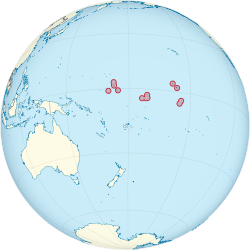
Back Кирибати Abkhazian Kiribati ACE Kiribati Afrikaans Kiribati ALS ኪሪባስ Amharic Kiribati AMI Kiribati AN Kiribas ANG कीरीबाती ANP كيريباتي Arabic
This article needs additional citations for verification. (October 2023) |
Republic of Kiribati Ribaberiki Kiribati (Gilbertese) | |
|---|---|
| Motto: Te Mauri, te Raoi ao te Tabomoa ("Health, Peace and Prosperity") | |
| Anthem: Kunan Kiribati ("Song of Kiribati") | |
 | |
| Capital | Tarawa[1] 1°28′N 173°2′E / 1.467°N 173.033°E |
| Largest city | South Tarawa |
| Official languages | |
| Ethnic groups (2020 census) |
|
| Religion (2020 census) |
|
| Demonym(s) | I-Kiribati |
| Government | Unitary parliamentary republic with an executive presidency |
| Taneti Maamau | |
| Teuea Toatu | |
| Willie Tokataake | |
| Legislature | House of Assembly |
| Independence from the United Kingdom | |
• Granted | 12 July 1979 |
| 20 September 1979 | |
| Area | |
• Total | 811.19[3] km2 (313.20 sq mi) (172nd) |
| Population | |
• 2021[5] estimate | 121,388 (192nd) |
• 2020 census | 119,438[4] |
• Density | 147.2/km2 (381.2/sq mi) |
| GDP (PPP) | 2023 estimate |
• Total | |
• Per capita | |
| GDP (nominal) | 2023 estimate |
• Total | |
• Per capita | |
| Gini (2019) | 27.8[7] low inequality |
| HDI (2022) | medium (137th) |
| Currency | Australian dollar ($)[9] (AUD) |
| Time zone | UTC+12, +13, +14 |
| Drives on | Left |
| Calling code | +686 |
| ISO 3166 code | KI |
| Internet TLD | .ki |
Kiribati (/ˈkɪrɪbæs/ ⓘ KIRR-i-bass,[10] Gilbertese: [kiɾibas]), officially the Republic of Kiribati (Gilbertese: Ribaberiki Kiribati),[11][12][3] is an island country in the Micronesia subregion of Oceania in the central Pacific Ocean. Its permanent population is over 119,000 as of the 2020 census, and more than half live on Tarawa atoll. The state comprises 32 atolls and one remote raised coral island, Banaba. Its total land area is 811 km2 (313 sq mi)[13] dispersed over 3,441,810 km2 (1,328,890 sq mi) of ocean.
The islands' spread straddles the equator and the 180th meridian, making Kiribati the only country in the world located simultaneously in all four hemispheres: the Northern, Southern, Western, and Eastern hemispheres. The International Date Line goes around Kiribati and swings far to the east, almost reaching 150°W. This brings Kiribati's easternmost islands, the southern Line Islands south of Hawaii, into the same day as the Gilbert Islands and places them in the most advanced time zone on Earth: UTC+14.
Kiribati gained its independence from the United Kingdom, becoming a sovereign state in 1979. The capital, South Tarawa, now the most populated area, consists of a number of islets, connected by a series of causeways. These comprise about half the area of Tarawa Atoll. Prior to its independence the country exported phosphate, but those mines are no longer viable. Fisheries and the export of copra drive much of the economy. Kiribati is one of the least developed countries in the world and is highly dependent on international aid for its economy.
Kiribati is a member of the Pacific Community, Commonwealth of Nations, the International Monetary Fund, the World Bank, and the Organisation of African, Caribbean and Pacific States, and became a full member of the United Nations in 1999.[14][15][16] As an island nation, the islands are vulnerable to climate change and tsunamis. Addressing climate change has been a central part of its international policy, as a member of the Alliance of Small Island States.
- ^ "About Kiribati – Kiribati For Travellers – Kiribati National Tourism Office".
- ^ a b Kiribati Census 2020. Retrieved 21 June 2022.
- ^ a b "Kiribati profile – Facts". BBC News. 23 May 2013. Retrieved 23 July 2020.
- ^ "2020 Census". Kiribati National Statistics Office. Kiribati National Statistics Office – Ministry of Finance & Economic Development. Retrieved 17 August 2024.
- ^ "Kiribati | Data". data.worldbank.org. Retrieved 25 November 2022.
- ^ a b "World Economic Outlook database: April 2023". April 2023. Retrieved 20 July 2023.
- ^ "Gini Index coefficient". The World Factbook. Retrieved 24 September 2024.
- ^ "HUMAN DEVELOPMENT REPORT 2023-24" (PDF). United Nations Development Programme. 13 March 2024. pp. 274–277.
- ^ Kiribati dollar is not the official currency.
- ^ "Kiribati". Encyclopædia Britannica. Retrieved 27 July 2010. "Kiribati: definition of Kiribati in Oxford dictionary (British & World English)". Oxford University Press. Archived from the original on 27 May 2016. Retrieved 31 December 2014.
- ^ Kiribati. The World Factbook.
- ^ Publications Office — Interinstitutional style guide — Annex A5 — List of countries, territories and currencies. Europa (web portal). Retrieved 28 January 2016.
- ^ "Kiribati: 2011 Article IV Consultation-Staff Report, Informational Annexes, Debt Sustainability Analysis, Public Information Notice on the Executive Board Discussion, and Statement by the Executive Director for Kiribati". International Monetary Fund Country Report No. 11/113. 24 May 2011. Retrieved 4 October 2011.
- ^ In February 2021, Kiribati announced it would be withdrawing from the Pacific Islands Forum in a joint statement with Marshall Islands, Nauru, and the Federated States of Micronesia after a dispute regarding Henry Puna's election as the forum's secretary-general.
- ^ "Five Micronesian countries leave Pacific Islands Forum". RNZ. 9 February 2021. Retrieved 9 February 2021.
- ^ "Pacific Islands Forum in crisis as one-third of member nations quit". The Guardian. 8 February 2021. Retrieved 9 February 2021.

